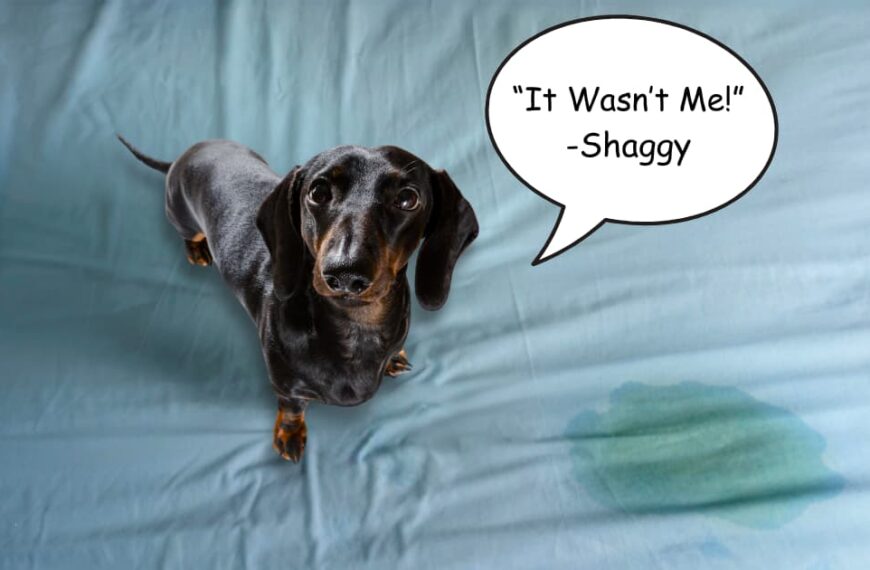Imagine the joy of bringing home a brand-new, plush dog bed, picturing your beloved canine cozily nestled in a blissful slumber.
However, as you return home, the anticipated joy is replaced by a surprising scene- your furry friend’s new bed transformed into a blizzard of shredded stuffing and torn fabric.
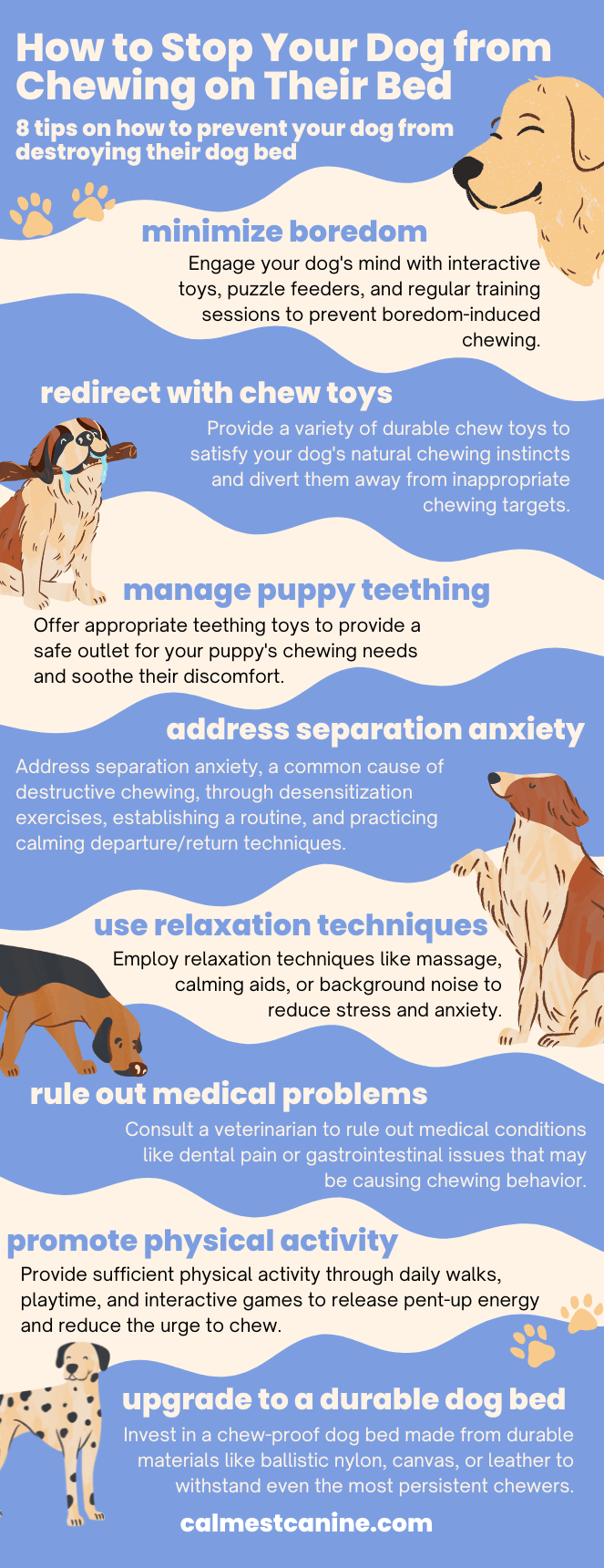
As a devoted dog owner, I can relate to that sinking feeling. And guess what? We’re not alone!
Data shows around 70% of dog owners have faced the challenge of bed-chewing behavior, leaving them frustrated with a costly need to replace it.
But fear not, because there’s a way to end to bed-chewing habits for good.
Ready to turn your furry shredder into a peaceful snoozer? Let’s uncover the most effective tips on how to stop your dog from chewing their bed to shreds.
- Why Do Dogs Chew Their Beds?
- How to Stop Your Dog From Destroying Their Bed
- Minimizing Boredom: Enrichment Techniques
- Redirection with Appropriate Chew Toys
- Navigating Puppy Teething
- Addressing Separation Anxiety: Tips for Comforting an Anxious Dog
- Relaxation Techniques for Stress Reduction
- Incorporating Physical Activity
- Tackling Underlying Medical Concerns
- Upgrading to a Chew-proof Dog Bed
- Additional Tips on How to Stop Your Dog from Chewing Their Bed
- Conclusion
- FAQs
- What age are dogs most destructive?
- Why is my dog so destructive all of a sudden?
- Will my dog ever stop chewing on everything?
- Should I punish my dog for destroying things?
- What smells will stop dogs from chewing?
- What taste do dogs hate to stop chewing?
- What could be the reason for my dog's abrupt behavior of consuming fabric?
- How do you know when your dog is happy?
Why Do Dogs Chew Their Beds?
Dogs are masters at keeping pet owners on their toes.
Known for their playful antics, our four-legged friends often take chewing to new heights, leaving even the coziest beds in pieces.
So, why do these adorable chewers target their beds?
Exploring Their Environment
Dogs, descended from wild canines, have an innate need to chew. Their ancestors used their mouths to explore and interact with their environment.
Thus, with its inviting softness and appealing features, a new dog bed becomes an irresistible territory for a curious canine.
While chewing is a natural instinct, it is crucial to redirect this behavior towards more appropriate outlets.
As a result, you can prevent potential safety hazards and protect your belongings.
The best solution would be to satisfy your loyal companion’s natural chewing instinct by offering them a variety of dog toys, frozen treats, and edible chews.
Boredom and Lack of Stimulation
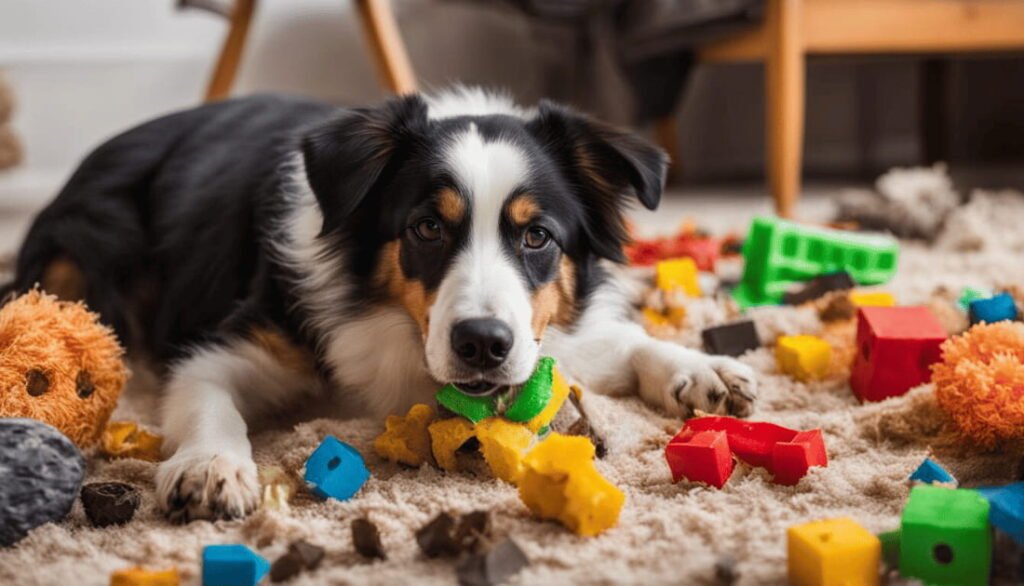
Boredom is a common culprit behind bed chewing behavior.
When left without enough physical or mental stimulation, dogs seek engaging outlets for their pent-up energy. And their beds often become the primary target.
Chewing on objects serves as a self-soothing mechanism for dogs.
It provides comfort and distraction when they become bored, similar to how humans find solace in activities like reading or solving puzzles.
When left alone or bored, dogs may resort to this self-soothing behavior.
To prevent this, ensure your dog receives adequate exercise and mental stimulation before leaving them alone.
Engage them in activities like brisk walks and fetch games.
While away, keep your canine occupied with sensory toys and interactive puzzle feeders to stop boredom-induced chewing.
Puppy Teething: A Natural Instinct
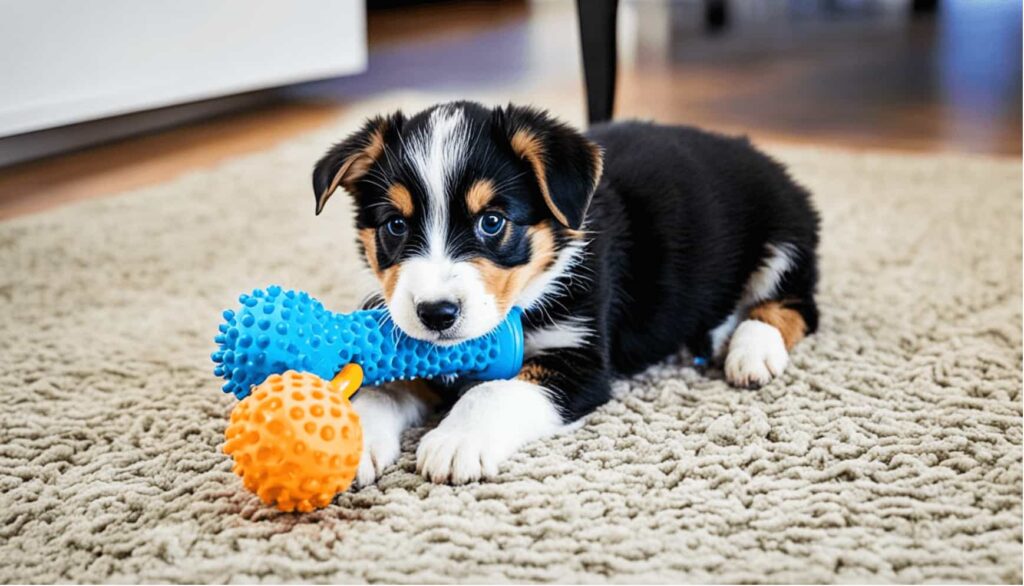
Similar to human babies, puppies experience the natural process of teething.
Between three weeks and seven months of age, young dogs grow 28 deciduous or baby teeth that will be replaced by 42 permanent teeth.
Like babies’ gums, puppies’ gums get sore and uncomfortable as their teeth grow.
During this period of puppyhood, your fur baby will gnaw on anything within their reach to relieve this pain and discomfort.
Most often, the soft material of a canine bed becomes the perfect choice.
However, chewing doesn’t stop at providing just comfort. Nibbling on firm objects like dog beds helps to stimulate tooth development.
While teething can be challenging for pet owners, there are effective ways to manage a puppy’s bed-chewing tendencies.
To help curb this inappropriate chewing, invest in toys and edible chews that provide relief and chewing satisfaction for your young pup.
Understanding Separation Anxiety

Dog owners may notice increased chewing when their companions are left alone. This behavior could stem from separation anxiety.
It is a condition that involves intense distress and destructive actions triggered by being left alone.
Several factors, such as abandonment, routine changes, or a natural need for companionship, can cause anxiousness in dogs.
When separated from their caregiver, anxious dogs may exhibit unwanted behaviors like chomping on their bed or inappropriate urination.
Occasional chewing alone doesn’t necessarily mean separation anxiety.
But if your dog also paces, digs, tries to escape, or vocalizes a lot when left alone, it would be a good idea to contact your vet.
To help your dog cope with this condition, try gradually increasing the duration of your absences, providing a safe and cozy den or crate, and consider using calming aids.
With patience and consistency, you can help your dog learn how to manage their anxiety and enjoy a more peaceful and relaxed life.
Unpacking the Impact of Stress
Like humans, dogs experience stress.
Whether stress is due to environmental changes or startling noises like fireworks, dogs will turn to stress-relieving behaviors such as chewing.
When dogs chew, it helps alleviate anxiety and nervousness, similar to how humans use nail-biting or stress ball squeezing.
Chewing releases endorphins, a natural mood-boosting hormone, in your canine’s brain as a natural form of stress relief.
The dog bed is more than a comfy place to lounge; it is now an emotional comfort object as well.
Identifying the stressor can be challenging, but there are ways to help your dog manage stress.
Regular exercise, engaging activities, and a peaceful home environment can help reduce stress in dogs.
Attention-Seeking Behavior
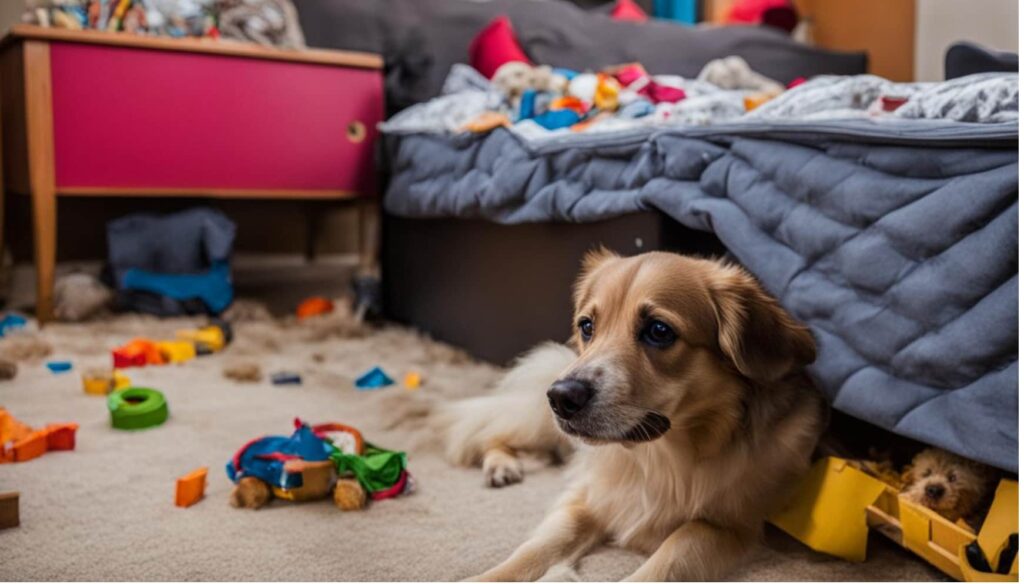
Dogs are social creatures who thrive on attention and interaction.
When dogs desire attention, they communicate through attention-seeking behaviors like barking, whining, and munching.
Even if tearing apart their dog bed leads to a negative response from their owners, dogs would prefer this interaction over feeling ignored.
Once your dog realizes they receive attention from chewing on their beds, they may continue this behavior.
We can help reduce attention-seeking behaviors by providing our dogs love, attention, and interaction through activities like playing, walking, and cuddling.
Lack of Exercise: A Root Cause
Dogs, especially high-energy breeds like Border Collies, Huskies, and Labrador Retrievers, require physical activity to stay healthy and happy.
When dogs don’t get enough exercise, they can become restless and overly excited.
Imagine your canine’s excess energy as a tightly wound spring ready to release at any moment.
Dogs typically release this pent-up energy through destructive behaviors like chewing on furniture, digging, or constant barking.
So, if your dog is chewing on their bed more than usual, it could indicate a need for increased physical activity.
To help reduce destructive chewing, increase physical exercise with brisk walks, fetch games, or park visits.
Exploring the Possibility of Underlying Health Issues
Dogs often chew their beds if they feel bored, stressed, or anxious.
Yet, as pet owners, we should know that health issues can lead to bed-chewing behavior.
For instance, an upset stomach due to allergies, food sensitivities, or worms can make dogs chew to feel better.
Dental issues such as loose or decaying teeth can cause dogs to chew on their dog beds to help alleviate discomfort.
Even in older dogs, a health condition known as Canine Cognitive Dysfunction Syndrome (CDS), similar to Alzheimer’s disease in humans, can lead to newfound chewing habits.
If you notice that destructive chewing occurs with other symptoms like decreased activity, appetite changes, digestive issues, or difficulty breathing, take your dog to the vet immediately.
Early detection and treatment can improve your canine’s well-being and curb undesirable behaviors.
How to Stop Your Dog From Destroying Their Bed
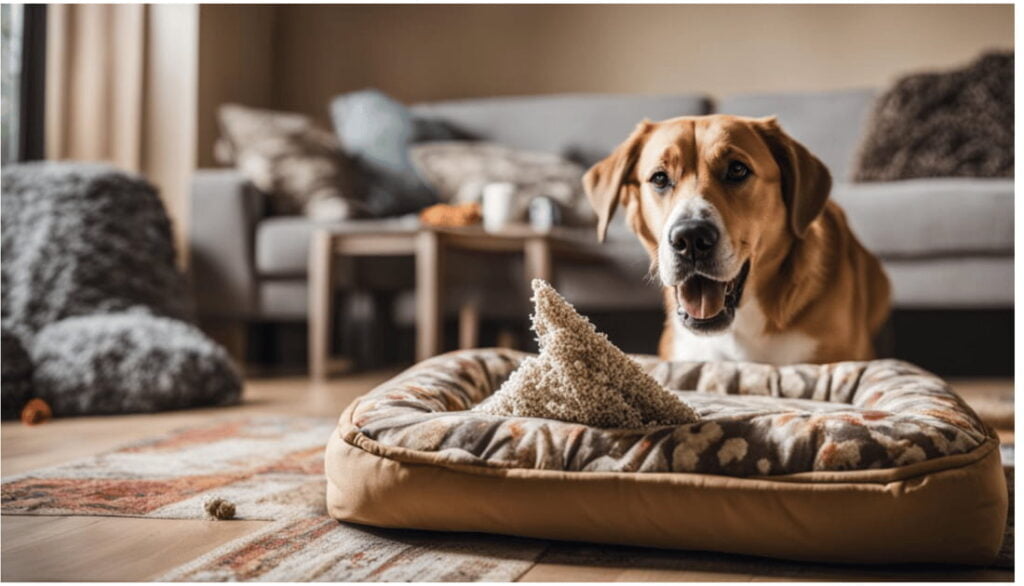
Tackling destructive bed-chewing behavior may seem like an uphill battle, but don’t fret!
Based on expert recommendations and research findings, we have compiled a list of practical strategies to help you address this common issue.
Minimizing Boredom: Enrichment Techniques
Boredom alone can drive your dog to bite on their bed.
To combat boredom-induced biting, provide your canine companion plenty of mental and physical stimulation throughout the day.
Some fun and engaging activities include:
- Interactive Dog Toys: Use puzzle feeders or toys that dispense treats when your dog plays with them. They help dogs release built-up energy and stimulate their mental activity.
- Hide and Seek: (one of my favorites) Play a game of hide-and-seek with your dog using their favorite toy or treats, or even hide yourself. This fun game stimulates their senses and reinforces the bond between you and your furry friend.
- Sensory Toys: Introduce toys with different textures and materials to engage their curiosity. Squeaky, crinkly, and soft plush toys provide variety and entertainment.
Tip: Provide your four-legged friend with a variety of chewable toys and bones. Be sure to rotate the toys regularly to keep them engaged and prevent them from getting bored.
Redirection with Appropriate Chew Toys
To tackle your pet’s destructive chewing habits, redirect their attention away from their beds by giving them an appropriate chew toy.
Choose durable and safe chewing toys to safeguard your belongings and teach them what items are off-limits.
Below are some strategies and insights I have used to keep my loyal companion’s teeth busy with toys rather than bed fabric:
- Mixing It Up: Regularly rotate different toys to keep things fresh and exciting for your pup.
- Understanding Preferences: Identify the type of toys your canine companion prefers. Doing so will ensure they have the most enticing option available.
- Puzzle Toys: Integrate toys that require some thinking to challenge and encourage longer attention spans.
- Reward-based Play: Use toys that can be filled with treats to provide extra incentive for your dog to play with over their bed.
To help you choose the correct chew toys for your dog, here is a table that outlines the types of toys they may chew on instead, their benefits, and their use cases.
| Type of Chew Toy | Benefits | Use Cases |
| Rubber Toys | Durable and long-lasting Helps clean teeth Provides jaw exercise | For teething puppies, aggressive chewers, and dogs who like to play fetch |
| Stuffed Toys (e.g. Stuffed Animals) | Soft and comforting Appeals to dogs who like softer textures Provides a sense of security | For gentle chewers, anxious dogs, and dogs who like to cuddle |
| Nylon Bones | Durable and long-lasting Helps clean teeth and control plaque A safer alternative to real bones | For adult dogs who are moderate to aggressive chewers |
| Rope Toys | Helps with dental health by reducing plaque Interactive for play and tug-of-war | For dogs who enjoy tug-of-war, interactive play, and fetch |
| Interactive Puzzle Toys | Keeps your furry friend mentally engaged Promotes problem-solving Slows down eating for fast eaters | For dogs who are bored easily or need more mental stimulation |
| Edible Toys | Provides long-lasting chewing satisfaction Promotes dental health | For dogs who like to gnaw on things but need a safe alternative to their bed or furniture |
Effective redirection tactics like these show that it’s possible to teach your dog (young or old) new tricks, especially when saving his bed from destruction.
By offering alternatives to their bed, you can help adjust your pet’s natural behaviors positively, benefiting your furry friend and their sleeping spot.
Tip: Supervise your dog when playing with chew toys to ensure a safe and enjoyable experience, promote responsible chewing habits and reduce the risk of any potential hazards.
Navigating Puppy Teething
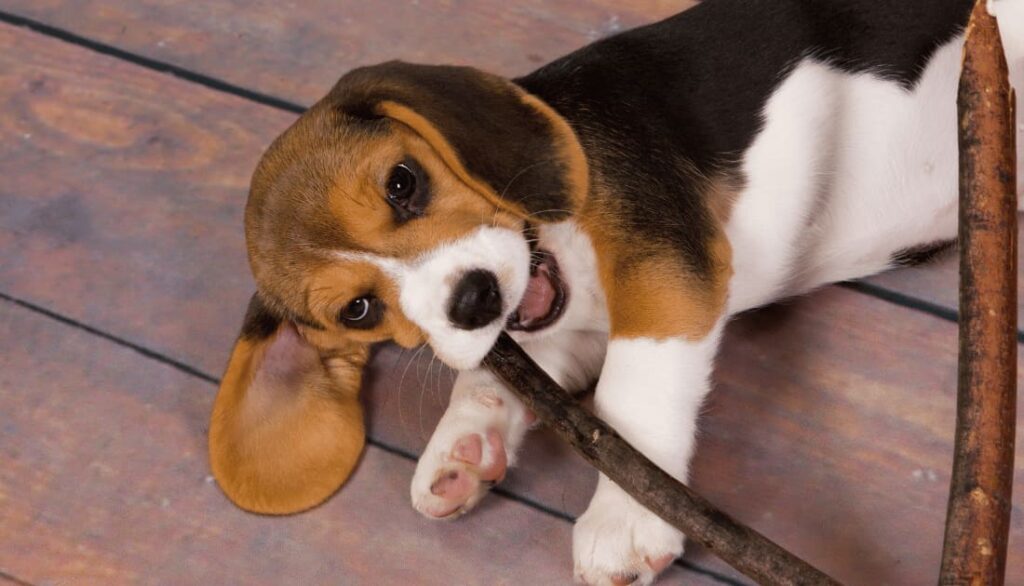
Teething is hard on both puppies and their owners.
When discomfort and the urge to chew are at their peak, trying to manage teething-related chewing can seem overwhelming.
Fortunately, the following options can soothe your pup’s sore gums and offer them a refreshing distraction.
- Frozen Toys: Look for a dog toy that can be stuffed with tasty treats like peanut butter, mashed bananas, or yogurt. Once filled, freeze the toy until it solidifies to help soothe their sore gums.
- Frozen Treats: Using a process similar to that of frozen toys, freeze food items like whole carrots, small pieces of watermelon, or apple slices. This is a healthy and convenient option for sore gums in puppies.
- Textured Toys: Find toys with different textures, such as bumps, ridges, or nubs. These textures help to massage dogs’ gums and clean their teeth.
Addressing Separation Anxiety: Tips for Comforting an Anxious Dog
Separation anxiety in dogs manifests in various ways, including biting on furniture, pacing, and escape attempts.
Helping a dog with severe anxiety requires patience, consistency, and positive reinforcement.
Here is a breakdown of effective strategies to address this issue:
- Gradual Desensitization: Gradually increase your pet’s exposure to being alone. Start by leaving your dog alone for short periods, and slowly increase the time that you are away.
- Establish a Routine: Dogs are creatures of habit. So, create a predictable routine for your dog, including consistent feeding, walking, and playtime schedules.
- Practice Calm Departures and Returns: Avoid creating a dramatic scene by departing quietly and without fuss. Upon your return, greet your dog calmly and refrain from excessive attention until they have settled down.
Relaxation Techniques for Stress Reduction

Stress can negatively impact a dog’s physical and mental well-being.
In fact, it can lead to problematic behaviors in dogs, such as chewing on their furniture.
Here are some helpful strategies to help your dog relax and prevent destructive chewing habits:
- Provide a Comfortable and Safe Space: Designate a safe and comfortable space for your dog, such as a crate or a quiet room with their favorite toys. The goal is to minimize disruptions and foster a sense of security.
- Ensure a Clean Sleeping Environment: Maintain a clean dog bed through regular washings. A fresh, tidy bed provides a comfortable and familiar space, helping dogs relax and find solace, especially during moments of anxiety or stress.
- Consider Calming Aids: Look into using pheromone diffusers, supplements, or anxiety wraps to help reduce anxiety and stress levels.
- Background Noise: Leave on music, nature sounds, or a TV show designed for dogs when you are away. The auditory and visual stimuli help foster a soothing atmosphere for your four-legged buddy.
It’s important to consider that not all genres or shows are made equal when providing a relaxing effect on canines.
To guide you in selecting suitable distractions for your pet’s anxiety while home alone, this table lists the types, their benefits, and my go-to picks!
| Distraction Type | Why it Works | My-Go-To Choice |
| Television | Visual stimulation; sense of activity and companionship | Animal-themed channels or soothing nature shows |
| Music | Auditory calming; masks outside noises that can cause stress and anxiety | Reggae and soft rock |
| Nature Sounds | Instinctually relaxing; simulated the sound of the outdoors | Bird sounds or recordings of a forest environment |
Incorporating Physical Activity
Physical activity for dogs is crucial for energy relief.
Without it, your pup will find other ways to release their pent-up energy, including destructive behaviors like chewing.
So make sure your dog exercises regularly because a tired dog is usually a less anxious dog.
Integrate the following activities into your routine to keep your dog happy and positively impact their well-being:
| Type of Exercise | Benefits | How Does it Reduce Chewing |
| Long walks or hikes | Physical exertion and mental stimulation from new environments | Alleviates boredom; satisfies curiosity without turning to undesirable behaviors |
| Fetch or Frisbee | High-energy, interactive play that fosters a bond between dog and owner | Targets their need for attention; diverts focus from munching to playing |
| Tug-of-war | Combines strength-building with problem-solving, and provides a healthy outlet for destructive habits | Helps release pent-up energy; satisfies their urge to gnaw on items; helps associate ‘chew toys’ with allowable objects |
| Agility training | Engages mind and body, improves concentration and discipline | Fosters discipline and impulse control; directs energy to a positive outlet; reduces stress and anxiety |
| Swimming | Excellent for joint health, improves flexibility, promotes healthy skin and coat | Makes your dog feel physically satisfied and too tired to chew |
Tip: Engage your dog in activities like walks or play sessions for about 30 minutes daily, ensuring they receive ample exercise for their physical well-being and overall health.
Tackling Underlying Medical Concerns
Some medical conditions can be the reason why dogs chew on their beds. However, not all instances of bed chewing indicate a medical problem.
If you notice an increased occurrence of destructive bed chewing, keep an eye on changes in your pup’s behavior, activity levels, and eating habits.
To monitor your furry friend, consider these steps:
- Track their Food and Water Intake: Track how much your dog eats and drinks daily. Note any significant changes in their appetite or water intake.
- Observe their Stool: Pay attention to your dog’s stool’s consistency, color, and odor. Changes in the stool could indicate a digestive problem.
- Regularly Inspect their Teeth and Gums: Check for signs of dental issues, such as loose or decaying teeth, red or swollen gums, or bad breath. Prompt dental care can prevent pain and discomfort that lead to unwanted chewing behavior.
Upgrading to a Chew-proof Dog Bed
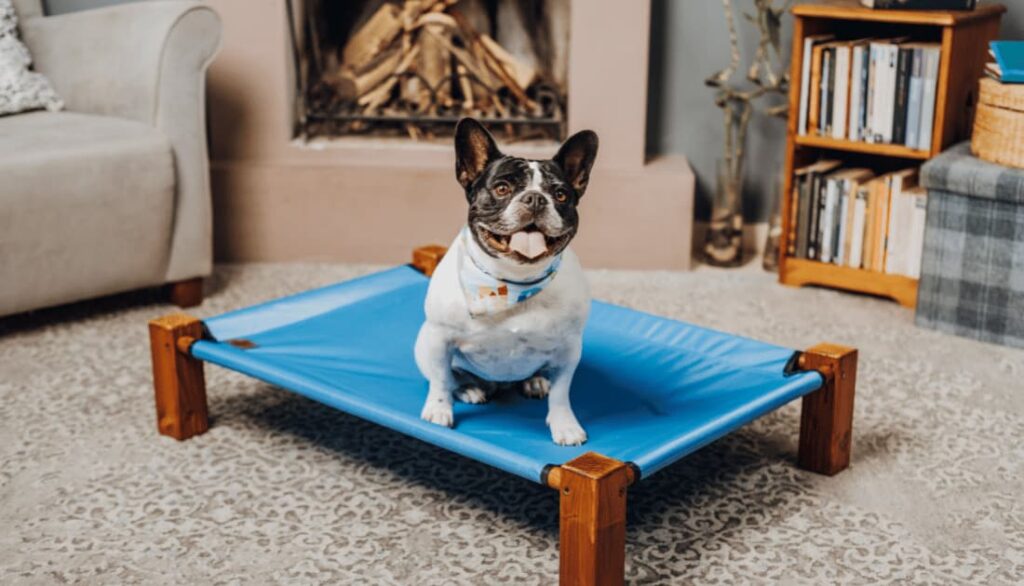
If your pooch’s bed is constantly being destroyed, look into replacing it with a more durable option, such as a chew-proof dog bed.
A chew-resistant bed is a type of bed that is specifically designed to withstand the persistent chewing behavior of even the most determined chewers.
These beds are made of durable materials resistant to chewing and scratching, like canvas, ballistic nylon, and leather.
Not only is a tear-resistant dog bed durable, but they also have replaceable covers, making them extremely easy to clean.
The following comparison helps showcase the difference between a standard pet bed and a chew-proof alternative:
| Feature | Standard Pet Bed | Chew-proof Pet Bed |
| Material | Often soft fabric | Reinforced nylon, metal |
| Durability | Varies, often less durable | Designed to withstand biting and chomping |
| Maintenance | May require you to keep buying a replacement | Replaceable covers allow for easy cleaning |
| Long-term Cost | Higher based on the number of replacements | Lowered, more cost-effective over time |
So, if you want to stop buying bed after bed, consider a heavy-duty bed for your dog.
Providing your dog with a durable pet bed can effectively deter bed-chewing and redirect this behavior to more appropriate items.
In addition to saving you the hassle of constantly replacing beds, it will ensure your dog has a comfortable and safe place to rest.
Additional Tips on How to Stop Your Dog from Chewing Their Bed
While tempting to address their bed-chewing behavior with quick fixes or harsh reprimands, these approaches are unsuccessful or can make it worse.
Therefore, here are additional tips that you can use to help your dog learn healthier chewing habits:
- Use an unpleasant tasting, deterrent spray on their bed that discourages them from mouthing on the treated area. You can make your own spray using water, distilled vinegar, and citrus essential oils. Or, you can purchase a deterrent spray from your local pet store.
- Avoid using shoes or household objects as alternative chew toys. This can confuse your dog and encourage them to chew on inappropriate items.
- Don’t ignore the issue or assume it will resolve by itself. The goal is to establish new boundaries with your pet.
- When your dog does something right, use positive reinforcement strategies like offering them dog treats.
- If possible, schedule regular veterinary check-ups. Even if your dog does not show any signs of illness, one of the best things you can do is take them for a wellness check-up at least once a year. That way, your vet can provide preventative care and identify any early signs of serious health issues.
Conclusion
Addressing furniture chewing in dogs requires patience, understanding, and a tailored approach.
Once you understand the reasons behind your pet’s bed chewing and implement these effective techniques, you can prevent this destructive behavior.
Redirecting a dog’s chewing to appropriate items is crucial in promoting healthier chewing habits.
Providing a variety of chewable toys and bones can keep them occupied and satisfied. And minimize boredom through regular exercise and mental stimulation.
Anxiety-induced chewing can be challenging to address, but it’s essential to identify and eliminate stressors that may be causing your anxiety.
Creating a relaxing and clean environment can help reduce your hound’s stress levels.
Using relaxation techniques and playing background noise can manage anxiety and discourage chewing.
Durable dog furniture is a practical solution to prevent constant bed replacements.
Every dog is unique, and finding the right strategies will help get them to stop destroying their bed and transform it into a place of rest, not destruction.


